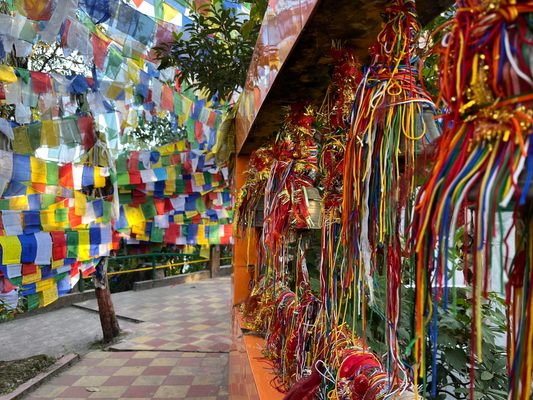About
At Darjeeling’s Mahakal Mandir, Balaram Sharma, a Hindu priest, chants Sanskrit mantras while sitting next to Nima Tshering Lama, a Buddhist priest, who is chanting prayers in the Bhutia language. At this unique Indian temple, one can experience a peaceful co-existence of two religions. It is located on the highest ridge of the town called “Daara” by the locals, and Darjeeling Observatory Hill by the British officers. The century-old Hindu Shiva temple is a worship center for both Hindus and Buddhists.
Surrounded by a canopy of tall coniferous pine trees, the temple grounds are filled with colorful Buddhist prayer flags, brightly painted prayer wheels, and hundreds of metal bells. Three black rocks, which are worshiped as the Shiva linga, sit in the sanctum sanctorum of this round temple. A white plaster figure of Nandi, the sacred bull of Shiva, sits at the entrance.
Across the temple premises, there are many other smaller shrines dedicated to Hindu gods and goddesses including Lord Shiva, Siddhi Sai Baba, Hanuman, Lord Ram, goddess Kali, and goddess Durga. The temple complex is not the only space atop the hill—there are a few caves and tiny rock-like structures hidden away in the lower parts of the hill. As the name suggests, Observatory Hill has a stunning view of the snow-capped Mount Kanchendzonga and the nearby town of Darjeeling.
According to local history, before the British came to this region there was a Buddhist monastery named Dorje-Ling on the hill established by a lama named Dorje Rinzing. Legend also has it that three Shiva Lingas self-manifested themselves on the hilltop. Around 1788, the monastery was destroyed during an invasion by the Nepalese Gurkha Army and converted into a place of worship dedicated to Mahakal with the three lingas, the gold-plated rocks that can be seen inside the temple today.
According to historical data, the foreign troops were driven out by the British East India Company during the Anglo-Nepalese War. In 1817, the territory was returned to the Chogyal of Sikkim. In the Treaty of Sugauli, Nepal had to cede all territories the Gorkhas had annexed from the Raja of Sikkim to the East India Company. Locals believe the name Darjeeling was derived from the name of the monastery Dorje-Ling. In Tibetan, Dorje means thunderbolt (originally the scepter of Indra), and Ling means a place or land, hence “the land of the thunderbolt.”
In the 1860s, the monastery was relocated to its present location in Bhutia Busty, a settlement a few kilometers below the Mall road. The monastery belongs to the Red Sect of Buddhist Lamas and originally was a branch of the Nyingma sect’s Phodang Monastery in Sikkim.
Related Tags
Know Before You Go
A 15-minute walk from the Mall road near Chowrasta in Darjeeling will lead to the temple. Temple opens early in the morning and stays open till late afternoon. Cabs and other vehicles are not allowed in the Mahakal mandir area. However, you can ride a horse or pony from Chowrasta. Be careful of the monkeys on the route, they can your snatch food.
Delhi and Rajasthan: Colors of India
Discover Colorful Rajasthan: From Delhi to Jaipur and Beyond.
Book NowPublished
December 21, 2022




























